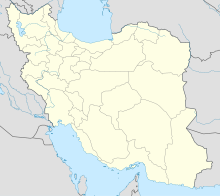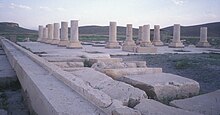Pasargadae
Coordinates: 30 ° 12 ′ 0 ″ N , 53 ° 10 ′ 46 ″ E

The old Persian royal seat of Pasargadae ( Persian پاسارگاد Pasargad , DMG Pāsārgād ; Greek Πασαργάδαι , Latin Pasargadai ) is located at 1900 m altitude in the Zagros Mountains on a plateau in the Persis ( Fars province) and was the first residence of the Persian Empire under the Achaemenids , about 130 km northeast of Shiraz .
Surname
The Elamite name is Batrakataš . The current name is a Greek transcription of the ancient Persian name Pâthragâda .
history
Pasargadae was founded by his first king Cyrus II , perhaps as an army camp, and by his successor Cambyses II between 559 BC. BC and about 525 BC Expanded. The city extended over about 300 hectares . At the time, the city had a sophisticated underground irrigation system.
Today you can see the ruins of the palaces with monumental gates , Apadana and the reception palace with rich plastic jewelry. In the holy district lies the fire temple with altars and the tomb of King Cyrus II. A cenotaph in the shape of a small stone house is placed on a base made up of six stone steps . The tomb stood in a spacious garden. Around 520 BC The residence of Dareios I was moved about 50 km to the southwest. The reconstructed remains of the capital are known under the Greek name Persepolis .
A third residence of the Persian Empire , which lasted until the attack by Alexander the Great in around 331 BC. Chr., Was located in Susa , not far from today's city Abadan near the Iraqi border. The three places, which were destroyed to different degrees, were once surrounded by residential areas. Other residences were the old Medes capital Ekbatana and sometimes Babylon .
Archeology and the history of discovery
In 1907, the German archaeologist Ernst Herzfeld (1879–1948) received his doctorate from the University of Berlin with a dissertation Pasargadae. Recordings and studies on Persian archeology with Eduard Meyer . Herzfeld first visited the ruins of Pasargadae in 1905. The first systematic excavations were carried out in 1928 by Herzfeld and his assistant Friedrich Krefter with financial support from the Emergency Association of German Science .
Later, Pasargadae was explored by Iranian and, for a short time, British archaeologists. A significant part of the first excavation documentation and fragments of wall paintings from Pasargadae are now in the Ernst Herzfeld estate in the Freer Gallery of Art in Washington, DC.
Gardens
David Stronach identified the gardens of the Cyrus residence. They were surrounded by porticoes . It is not certain whether there were other permanent buildings here or whether the king resided in an army camp.
Stone-lined canals defined two adjacent gardens. The canals presumably follow a natural river bed and may have been used to transport the building material. Stronach reconstructed a Tschāhār Bāgh with an area of 145 × 112.5 m. Its boundaries were defined by smaller canals that led to the transverse wall of the palace to the north and a small pavilion to the south. Stronach assumed that the throne of Cyrus stood in the axis of one of the gardens. Additional channels were discovered during a geomagnetic survey by a team from the Iranian Cultural Heritage Organization of the Ministry of Research and the Ministry of Monument Preservation and the French Maison de l'Orient of the University of Lyon and the CNRS .
The pavilion had a stone rectangular base measuring 11.5 x 10.2 m. In the north-east and south-west, the building had a portico each , 17 m long and 4.3 m wide, which protruded over the building. Only a few remains of the building have survived.
A stone bridge spanned one of the main canals. It was 15.6 m long and 16 m wide and provided with three rows of columns, which were erected about 4 m apart and had a diameter of about 90 cm. They were originally about 2 m high and had no capital .
reception
In 1658 Thomas Browne published an essay on The Garden of Cyrus, or the quincuncial, lozenge, or network plantations of the ancients, artificially, naturally, mystically considered. He was mainly concerned with the quincunx , the arrangement of trees in a diamond pattern, which he compared to the Greek cross and associated with the crucifixion of Christ. Browne emphasizes the importance of clear order in gardening. Cyrus arranged trees like his armies (“Disposing his trees like his armies in regular ordination”).
See also
literature
- Peter Calmeyer : Figural fragments from Pasargadae after drawings by E. Herzfeld. In: Archaeological Communications from Iran. Vol. 14, 1981, pp. 27-44.
- Ernst Herzfeld : Pasargadae. Recordings and studies on Persian archeology. In: Klio . Vol. 8, 1908, pp. 1-68.
- Ernst Herzfeld: Report on the excavations of Pasargadae in 1928. In: Archäologische Mitteilungen aus Iran. Vol. 1, 1929, ISSN 0066-6033 , pp. 4-16.
- Ali Mozaffari (Ed.): World Heritage in Iran: Perspectives on Pasargadae. Ashgate Publishing , 2014, ISBN 978-1-4094-4844-0 .
- David Stronach: Pasargadae. A report on the excavations conducted by the British Institute of Persian Studies from 1961 to 1963. Clarendon Press, Oxford 1978, ISBN 0-19-813190-9 .
- David Stronach: Ernst Herzfeld and Pasargadae. In: Ann C. Gunter, Stefan R. Hauser (Eds.): Ernst Herzfeld and the Development of Near Eastern Studies. 1900-1950. Brill, Leiden et al. 2005, ISBN 90-04-14153-7 , pp. 103-136.
- David Stronach, Hilary Gopnik: Pasargadae. In: Encyclopædia Iranica , July 20, 2009
Web links
- Entry on the UNESCO World Heritage Center website ( English and French ).
- Ernst Herzfeld Persepolis Archive . Freer Gallery of Art, Washington DC
Individual evidence
- ↑ Remy Boucharlat: Pasargadae. In: Iran. Vol. 40, 2002, p. 279, JSTOR 4300633 .
- ^ David Stronach: Excavations at Pasargadae: Third Preliminary Report. In: Iran. Vol. 3, 1965, p. 16.
- ↑ Herzfeld Resource Gateway. Freer Gallery of Art and Arthur M. Sackler Gallery Archives, accessed October 22, 2018.
- ^ David Stronach: Pasargadae, a report on the excavations conducted by the British Institute of Persian Studies from 1961 to 1963. Clarendon Press, Oxford 1978.
- ↑ Remy Boucharlat: Pasargadae, 2002, pp 279-280.
- ^ David Stronach: Excavations at Pasargadae: Third Preliminary Report, 1965, p. 30.
- ^ David Stronach: Excavations at Pasargadae: Third Preliminary Report, 1965, p. 31.
- ^ David Stronach: Excavations at Pasargadae: Third Preliminary Report, 1965, p. 29.
- ↑ Susan Stewart: Garden Agon. In: Representations. Vol. 62, 1998, p. 134.


